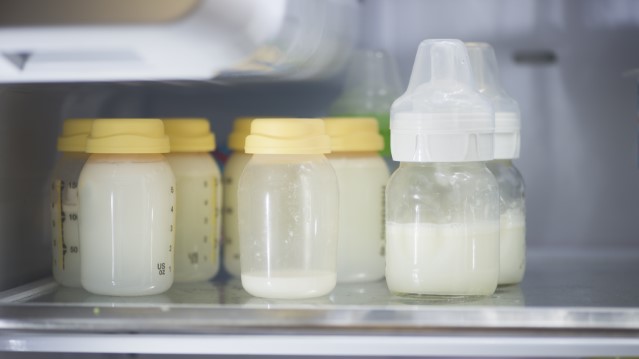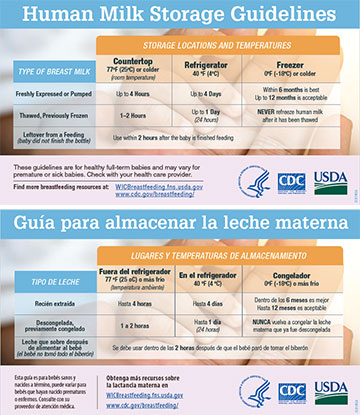At a glance
Various factors affect how long human milk can be stored safely. The storage and preparation techniques recommended can help maintain the safety and quality of expressed breast milk for the baby's health. This page provides information for storing human milk at different temperatures and for preparing human milk after storage.

Human milk storage information
Download Storage and Preparation of Breast Milk in English or Spanish.

Before expressing or handling breast milk

Wash your hands well before expressing or handling breast milk.
Wash your hands well with soap and water. If soap and water are not available, use an alcohol-based hand sanitizer that contains at least 60% alcohol.
Mothers can express breast milk by hand or with a manual or electric pump.
If using a pump, inspect the pump kit and tubing to make sure it is clean. Discard and replace moldy tubing immediately.
If using a shared pump, clean pump dials, power switch, and countertop with a disinfectant wipe.
Storing breast milk after expressing
Use breast milk storage bags or clean, food-grade containers to store expressed breast milk. Make sure the containers are made of glass or plastic and have tight fitting lids.
Never store breast milk in disposable bottle liners or plastic bags that are not intended for storing breast milk.
Freshly expressed or pumped milk can be stored:
- At room temperature (77°F or colder) for up to 4 hours.
- In the refrigerator for up to 4 days.
- In the freezer for about 6 months is best; up to 12 months is acceptable. Although freezing keeps food safe almost indefinitely, recommended storage times are important to follow for best quality.
Storage tips

Clearly label breast milk with the date it was expressed.
Do not store breast milk in the door of the refrigerator or freezer. Storing it further inside will help protect the breast milk from temperature changes when the door opens and closes.
If you don't think you will use freshly expressed breast milk within 4 days, freeze it right away. This will help to protect the quality of the breast milk.
When freezing breast milk:
- Store small amounts to avoid wasting milk. Store in 2 to 4 ounces or the amount offered at one feeding.
- Leave about one inch of space at the top of the container because breast milk expands as it freezes.
If you deliver breast milk to a childcare provider, clearly label the container with the child's name. Talk to your childcare provider about any other requirements for labeling and storing breast milk.
Breast milk can be stored in an insulated cooler with frozen ice packs for up to 24 hours when traveling. At your destination, use the milk right away, store it in the refrigerator, or freeze it.
Safe thawing of breast milk

Remember: First in, first out. Always thaw the oldest breast milk first. Over time, the quality of breast milk can decrease.
You can thaw your breast milk by putting the container in the refrigerator overnight, in warm or lukewarm water, or under lukewarm running water.
Never thaw or heat breast milk in a microwave. Microwaving can destroy nutrients in breast milk and create hot spots, which can burn a baby's mouth.
If you thaw breast milk in the refrigerator, use it within 24 hours. Start counting the 24 hours when the breast milk is completely thawed, not from the time when you took it out of the freezer.
Once breast milk is brought to room temperature or warmed, use it within 2 hours.
Never refreeze breast milk after it has thawed.
Feeding expressed breast milk
Breast milk does not need to be warmed. It can be served room temperature or cold.
If you decide to warm the breast milk, here are some tips:
- Keep the container sealed.
- Place the sealed container into a bowl of warm water or hold it under warm, but not hot, running water for a few minutes.
- Test the milk's temperature by putting a few drops on your wrist before feeding it to your baby.
- Do not heat breast milk directly on the stove or in the microwave.
Swirl the breast milk to mix the fat, which may have separated.
If your baby did not finish the bottle, use the leftover milk within 2 hours. After 2 hours, leftover breast milk should be discarded.
Safe cleaning of infant feeding items and pumping equipment

Clean, sanitize, and store all feeding and pumping equipment.
Carefully clean, sanitize, and store pump equipment, baby bottles, and other feeding items to protect your breast milk from contamination. See CDC guidance on how to safely clean and store pump equipment and infant feeding items.
Resources
Information is adapted from the Academy of Breastfeeding Medicine's (ABM) Clinical Protocol #8: Human Milk Storage Information for Home Use for Full-Term Infants, Revised 2017.
